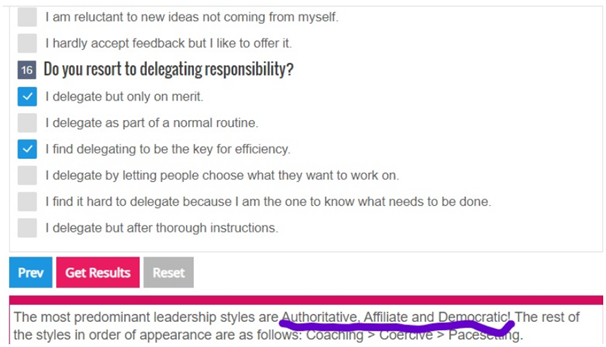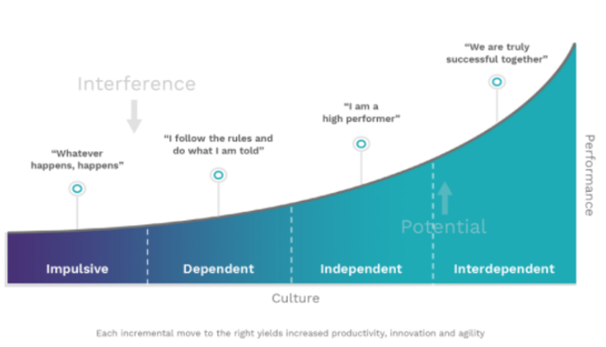Leadership Assignment: Reflective Portfolio On Key Learnings
Question
Task:
Description of Leadership Assignment Task and Purpose:
You will compile evidence for your portfolio throughout the module and then write a 3,500-word reflective commentary which captures your learning and identifies strategies to improve your leadership practice.
The portfolio should have an introduction (approx. 250 words) and conclusion (approx. 250 words) and the following four sections:
A critique of leadership theory learned throughout the module. The critique should demonstrate an understanding of key concepts and theories of leadership in organisations. You should use examples drawn from your own research (case studies, news articles, class discussions etc) to illustrate theory in practice. (approx. 750 words)
An evaluation of a problem-based event. You should use theory and activities undertaken throughout the module to demonstrate and evaluate how you have engaged and learned from a problem-based event. You should critique the tools and techniques which you used (eg appreciative enquiry, NESTA etc) and the leadership skills and competences which you demonstrated. (approx. 750 words)
An audit of your own strengths and weaknesses as a leader. This skills analysis should refer to evidence (eg 360-degree leadership survey, Johari window, leadership vision etc) to support your personal evaluation of your strengths and development needs and include reference to self-leadership theory. You can include this evidence as appendices in your portfolio which will not be included in the word count but please only include appendices referred to in your portfolio. (approx. 750 words) A personal leadership development plan. You should prepare a development plan which demonstrates how you will continue to practice and enhance your leadership skills over the next 18 months. You should identify objectives (key goals), activities (what learning/development you will undertake) and outcomes (measures of success) over the next 0-6 months; 6-12 months and 12-18 months. (approx. 750 words)
Knowledge & Skills Assessed:
Subject-Specific Intellectual Skills: Analyze and appraise organizational effectiveness and need for change in relation to the ethical and responsible management of human, financial, and other resources (PO10); assess and solve complex and unpredictable problems and make decisions based on identifying and evaluating appropriate alternatives (PO11)
Subject-Specific Practical Skills: effectively use information and communication technologies relevant to the Management discipline (PO15); evaluate, integrate and apply theory, practice and reflection in an ethical and responsible way (PO16); acquire, evaluate and synthesize a range of information for diverse organizational purposes including new situations (PO17); recognize, analyze and develop responses to ethical dilemmas in organizational contexts (PO19)
Transferable Skills and Attributes: communicate effectively according to different situations and in relation to various organizational constituents (PO21); evaluate the rigor and relevance of published research for new situations, adapting existing research approaches as appropriate (PO22); demonstrate ability to operate effectively within a group environment (PO26).
Answer
Introduction
Reflective learning prepared within this leadership assignment is the way learners think about the aspect they learn, read and acquire related to their learning session. Reflective learning is actually a process that helps students to understand their critical strengths as well as weakness related to the learning process (Colomeret al. 2020). Presenting reflective learning reports would help me to describe my idea about leadership skills and knowledge. In the present context, reflective learning is going to understand the critique of leadership theory as well as problem-based learning from the event.
The present reflective report has various sections identifying the learning experience gathered by me. In the first section, I have described the leadership theory learned throughout the module. In this section, key concepts about leadership theory have been described properly. In the second section of the reflective learning report, a problem-basedevent has been identified. Learning from that event has been evaluated in this section as well based on the understanding level. In the third section of the reflective personal strength and weaknesses that I have, had been described. With the help of a 360-degree leadership survey, my overall leadership skill has been explained in this section. In this section, theories and models have also been used to support the learning outcome of this report. The last section of the reflective report consists of a personal development plan. In this section, I have presented several personal development objectives along with the action required to develop those areas.
Critique of leadership theory
From the module, I have learnt several forms of leadership theories and models that would help make in future to become successful professionals. I have learnt different forms of leadership Theory as well as leadership styles from the module. As stated by Gandolfi and Stone (2018), leadership is the art of motivating and influencing people and helping them reach their goals. I have learnt from the module that the primary function of a leader is to guide and influence people and help them cope with complex situations in order to achieve the desired goal. In addition to this, I have learnt that a ladder must have a certain form of qualities in order to become successful. As mentioned by Kamales and Knorr (2019), communication is the most important skill of a leader for the management of cultural diversity and conflicts. I have learnt that other than communication, timemanagement, self-awareness, critical thinking, decision-making skills and motivation are necessary skills that a leader must have. Flexibility and adaptability are other important areas that determine the success and failure of a leader (Chow, 2020).
During the module course, I have learnt different styles of leadership as well as leadership Theory helps in increasing my knowledge about criticism of leadership. As opined by Woods (2020), the democratic leadership style focuses on the wellbeing of employees and invites them into the organisational decision-making process. In this type of leadership, members of a team take a more participative role in the decision-making process that helps boost their morale and value. For example, Apple being a global tech organisation focuses on a democratic leadership style (Financhill.com, 2020). Tim Cook, CEO of Apple, lets the talents of everyone at Apple contribute to the company's success. It does not mean that complete decisions are taken by the employees, but the decisions are meant to be implemented by keeping the focus on meeting the needs of each and every individual.
During the module courses, I have also learnt about the autocratic style of leadership. In this type of leadership, leaders take control over the decision as well as activities of team memes. As mentioned by Chukwusa (2018), team members are not given a single power to take and make decisions on their own and the autocratic style of leadership. As leaders take their own decisions and do not provide opportunities for team members to take part in the decision-making process, there is a lack of creativity. I have also learnt about the transformational leadership style, where the leader focuses on creating and managing change by motivating. According to Alqatawenh (2018), transformational leaders follow a combination of four leadership styles. These four leadership styles are an idealised influencer, intellectual stimulation, inspirational motivation and individualised consideration. I have learnt that transformational leaders help employees to adjust to the situation where change is required within the organisation. For example, Jeff Bezos, the founder of Amazon, follows a transformational leadership style for emanating continuous change in an organisation (Topicinsights.com, 2020). With the help of this type of leadership, he was able to transform the start-up company into a billion-dollar global business. Under such a leadership style, he constantly motivates his global level employees to adjust to the change and manage change as per the demand of customers.
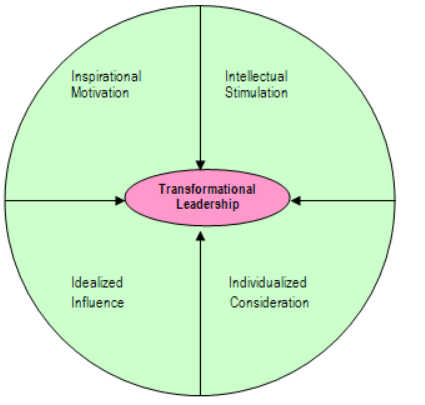
Figure 1: Transformational leadership
(Source: Alqatawenh, 2018)
From the module courses, I have also learnt about various leadership theories as well as motivation theories. As opined by Wyatt and Silvester (2018), the Trait Theory of leadership focuses on providing ideas about some leadership traits. Asper this theory, I have learnt that a successful leader must have interests, abilities, and personality traits.
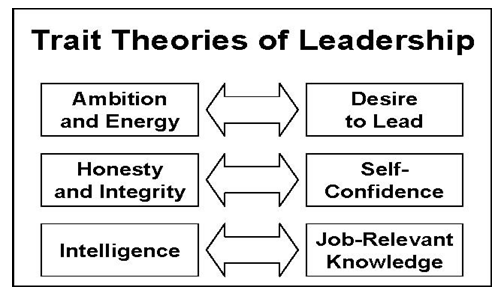
Figure 2: Trait theory of leadership
(Source: Wyatt and Silvester, 2018)
The important trait that determines the success of a leader as per this theory are as follows:
Achievement drive
Cognitive ability
Charisma and knowledge
Honesty and integrity
Emotional intelligence
Leadership motivation
Self-confidence
I have also learnt about the Contingency Theory of leadership from the module courses that have helped me to develop my code understanding of leadership. As pointed out by Abba et al. (2018), As per the contingency Theory of leadership, leaders must have the capability to adjust to a particular situation. I realised that a leader is successful in one circumstance and an ineffective leader in another one. As opined by Salihu (2019), situational leaders do not have standard leadership, but they implement leadership as per the situation. I have also learned about the situation and leadership Theory that focuses on how a successful leader must be able to adjust to the situation to handle complex situations.
Problem-based event
Problem-solving is the most important and required skill for a successful, especially in the workplace area. I have learnt from the module that problem-solving skills not only allow people to manage their own problems but also help them to take proper decisions towards the achievement of future goals. I have researched much about the problem-solving skills and cases that have helped me to develop my core idea regarding the importance of problem-solving. I have identified a real case of an Ester “New NESTA report makes a case for collaborative problem-solving" (Matrixni.org, 2017). I have researched the case taken by Nesta carefully and dedicated all my research skills to criticize this problem-based event.
I have effectively applied my critical thinking skill to understand the core concept presented in his case. In addition to this, I have applied my content research skill to extract the idea presented in this selected problem-based event after all. I have identified from the case that NESTA argues that the ability to solve problems is a crucial skill (Nesta.org.uk, 2017). It is necessary for people to manage conflicts and problems in the workplace, but most education systems do not focus on this aspect effectively. Nesta has shown that Collaborative problem-solving (CPS) is really taught in the school that can make notary in force the thinking capability of people. The significance bad here lies in this aspect are the inability of the tutor to implement proper strategies to make students ever about the CPS. I have strong critical analysis skills that allow me to identify the fact presented by Nesta. As per Nesta report on the problem-basedevent, teacher training, better resources and system-level support are necessary to reinforce the concept of CPS and its importance in education and working areas (Matrixni.org, 2017). In order to identify the effectiveness of collaborative problem-solving skills, Nesta has taken a collaborative problem-solving approach with reference to Code Clubs in England. In the Autumn term of 2017, we worked with six Code Clubs in schools in England (Nesta.org.uk, 2017). The approach has been taken to identify the extent to which collaborative problem-solving skills are taught in schools in England. Nesta has provided completed programmes and questions to students to the school to identify their ability to solve the problem efficiently and collaboratively. After getting the result, it has been compared to the standard approaches to identify the collaborative problem-solving skills of those students in the school.
In this aspect, I have applied my critical content analysis skill and have evaluated the findings carried out by Nest from the problem-based event. The findings of Nesta have shown that in informal learning environments, collaborative problem-solving approaches are mandatory. As mentioned by Graesser et al. (2018), collaborative problem solving is a necessary skill for people, especially in the work area, to make proper decisions and manage issues. In this regard, I have identified from the problem waste event carried out by Nesta that Strong encouragement is necessary for teachers within the schools in England to improve collaborative learning skills first. Nesta has suggested that worked example-based resources are necessary for increasing the interest of children towards collaborative problem solving (Matrixni.org, 2017). Allocating space for children to interact with others would be a greater idea for encouraging collaborative problem-solving.
From the problem-based event, I have learnt several forms of things as well as applied my skill to research the content very carefully. I have applied the information system that allows me to find out the problem with the event carried out to buy Nesta. I have also given attention to detail problem-based events so that I can understand the aspect carefully. As mentioned by Adams and Blair (2019), time management is a necessary skill for a student in the education sector, determining the capability to complete a task efficiently. I have applied my time management skills so that I can analyse the problem-based event of Nesta very carefully. But it is necessary to state that I don't have much time to recharge problem-based events published by Nesta. Overall, I have applied my content research and identified the recommendation provided by me to manage the issue. Nesta has recommended that training is necessary for the out-of-school learning sector and volunteer educators. Nesta has also suggested that funds existing is necessary to implement problem-based learning processes into the higher education sector at all.
Strength and weakness
For assessment of my personal leadership strength as well as weakness, I have carried out the most important form of self-leadership assessment. With the help of a 360-degree leadership survey, Johari window and leadership vision (Oliver and Duncan, 2019), I have assessed my personal skills and attributes of a leader.
Strength
From the result, I have identified that I am independent and do not rely on others for the achievement of certain criteria. I focus on delegating my efficiency towards the achievement of success only. As mentioned by Chukwusa (2018), autocratic leaders never focus on the decisions and opinions of others to make the decision-making process creative. I have strength regarding affiliate leadership as I focus on the well-being of others [Refer to Appendix]. The democratic style of leadership is another important strength of my helping others to take part in the decision-making process in group projects. As opined by Iordanoglou (2018), problem-solving is the most important skill for a successful leader managing complex issues. The leadership test also allows to find my strength regarding problem-solving and active listening skills (Nowack and Zak, 2020). From the result of the Johari window, I have also identified a certain form of my leadership skill. I have identified that I am able to take risks and accept any type of unpredictable outcome determining my transformational leadership style. As mentioned by Changwonget al. (2018), critical thinking is necessary for a leader to implement best-suited decisions against conflicting situations. From the Johari window test, I have also identified my strength in the knowledge and ability to build relationships with others [Refer to Appendix]. As a result, I am shy and silly in some aspects, but overall, I am very trustworthy, and my people can easily trust me. I am very adaptive and flexible, which helped me to become self-conscious and it determines situational leadership theory. I am emotionally very intelligent, which is my great strength as a leader to motivate and guide people even in conflicting consequences.
As per 16 personality tests results, I have identified that I am a Protagonist and open-minded [Refer to Appendix]. Strong decision making is the most important strength of my leadership as per this personality test. I am reliable as well as passionate, which can help me in future become a strong leader exerting creativity and innovation within the workplace area. I have also found that I am very inspirational, and I have the capability to achieve a positive change. From the leadership vision test, I have identified that I am a good leader [Refer to Appendix].From the test, I have been identified that I am capable enough to lead people to what's the right direction by motivating them. As opined by Kamales and Knorr (2019), a successful leader is able to interact with the environment where people exert their ideas. From the leadership vision test, I have identified that I am a very assertive and positive thinker that would help me to motivate my people in future.
Weakness
From all three tests, I have identified certain forms of my weakness as a leader that I need to develop further. From the 360-degree leadership survey, I have identified that authoritative, affiliate and democratic leadership are the most common forms of leadership. As a successful leader, it is necessary for me to understand myself as well as others, but I am lacking in understanding others as well as me. As mentioned by Gandolfi and Stone (2018), leaders must have the energy to implement something that could help to improve their personal traits. But from the personality test, I have identified I have weakness regarding energy to bring changes, but I push others to bring changes. Overly empathetic, which is not a good skill for a leader, and it considered it as leadership weakness (Ventura,2019). I also have a lack of confidence that hinders me from implementing the most effective strategy for persuading other people, unfortunately. As reported by Ciulla (2020), ethics is the most important principle of leadership that determines whether a leader is successful or not. But I lack truth or justice, which creates my weakness and hinder me from becoming a successful leader. I have also identified from the leadership vision test that I have weaknesses regarding creating a robust and compelling vision of the future. I also have a lack of managing people and their performance efficiently. I also have poor time management skills that I need to develop to complete a task within a deadline and spread the skill among my people too.
Leadership development plan
Based on the learning from the model as well as my performance to research a problem with the event from Nesta, I have identified certain areas that I need to develop. From all the leadership tests, I have also identified certain weaknesses that I still need to improve. I need to develop leadership ethics in the first 3 months of my development plan, and then I want to develop my confidence as a leader. I will develop my time management skill within the next 12 months and then develop my critical thinking skill within 18 months. I have already identified that I need to develop within the next 18 months or that I can become a successful leader in my future professional career. With the help of a SMART objective and action plan, I have expelled my future leadership development plan. This is as follows:
|
Development objectives |
Specific (S) |
Measurable (M) |
Achievable (A) |
Realistic (R) |
Time-bound (T) |
Action required to achieve the goals |
|
Leadership ethics |
It is specific because it would helpto develop trust and loyalty within working areas (Ciulla,2020). |
The success of this leadership skill can be measured by identifying the level of responsibility and sustainability of people to handle working operations efficiently. |
I can develop this skill by irradiating biases into the workplace. In addition to this, promoting clear communication can an individual to manage issues related to bias in the workplace areas (Cardon et al. 2019). |
The development of leadership ethics is realistic because it will help to establish justice and trust within working areas between people |
0 to 3 months |
Alignment of value with the truth and helping people to the fullest (Flanigan, 2018). A decision needs to be taken concisely, and individuals should be aware of their own biases. |
|
Confidence and energy |
It is specific as it will allow to increase the leading productivity and improve employee’s motivation level. |
It can be measured by identifying the behaviour of a leader and their followers in the workplace, whether they are independent to manage issues or not (Onyalla,2018) |
I think staying active and aware of any practical situation can help me to develop my self-confidence. In addition to this, I have to be aware of my role and responsibilities so that I can guide people to the fullest. |
Confidence is a great virtue that determines how efficient a leader is in guiding and managing people (Ciulla, 2020). In order to hold confidence, it is necessary to be aware of the situation at work every time. |
3 to 6 months |
Realistic self-awareness is necessary to build confidence at work as a leader. The development of one's comfort zone in the working area can also help to increase the energy of a leader to motivate and guide others. |
|
Time management |
Time management is specific because of managing quality and timely delivery of projects within working areas. |
The success of this skill can be measured by identifying the fact that whether leaders are able to complete a task within the deadline or not. |
Splitting complex tasks into smaller ones and prioritizing important tasks first. Completing difficult tasks within a very short time so that I can manage my deadline. |
Time management skill is realistic because they would not only help to completetask within a deadline but would also help to deliver a quality outcome too (Adams and Blair,2019) |
6 to 12 months |
I need to prioritize the most important task first, followed by the non-important one at last. In addition to this, I need to focus on completing complex tasks within a very short ti8me so that I have time to analyse the efficiency of completing a task as a leader. |
|
Critical thinking skill |
With the help of critical thinking, I can be able to manage complex issues within a short deadline (Basri, 2019) |
The success of having critical thinking would be measured by evaluating the ability of a leader to criticize an event and find out the root causes of any conflict. |
Dealing with biases is the first activity required to achieve success in developing critical thinking. Concise and systematic thinking can help to criticize the event efficiently (Wati and Halim,2020). |
I think critical thinking is realistic because it will help to understand an incident concisely. Based on critical thinking, I can be able to understand the needs and want of my team members efficiently. |
12 to 18 months |
Concise and systematic thinking is necessary for thinking about a phenomenon critically (Al Mamun et al., 2018). |
Table 1: Leadership development plan
(Source: Developed by author)
Conclusion
From the overall discussion, I can say that I have learnt about various forms of leadership theory and leadership style. I have carried out several assessments to identify my personal strength and weakness regarding leadership. Those assessments not only helped me to identify my strength but also helped me to evaluate the action required to develop the area where the weakness lies. From the 360-degree feedback, I have identified that I have strengths regarding active listening skills that will allow me to understand the needs and wants of my team members who are from different cultural groups. From the 16 personality traits, I have identified my strengths as a good decision-maker. On the other hand, leadership vision tests help me to identify my strength, that I am able to take risks and accept any type of unpredictable outcome.
I have also identified my strength in content research skills regarding the evaluation of problem-based events carried out by Nesta. I have also identified certain forms of weakness that I need to develop in future to become a successful leader. I need to have a systematic thinking process, too, so that I can criticise any incident related to my future leadership role. I need to build my energy and confidence so that I can spread confidence among my team members. I need to develop my time management skill so that I can complete difficult tasks within the deadline without compromising their quality. The development of leadership ethics would also help me to become a good leader in future.
Reference list
Abba, M., Yahaya, L. and Suleiman, N., 2018. Explored and critiqued contingency theory for management accounting research. Journal of Accounting and Financial Management ISSN, 4(5), p.2018.
Adams, R.V. and Blair, E., 2019. Impact of time management behaviors on undergraduate engineering students’ performance. SAGE Open, 9(1), p.2158244018824506.
Adams, R.V. and Blair, E., 2019. Impact of time management behaviors on undergraduate engineering students’ performance. Sage Open, 9(1), p.2158244018824506.
Al Mamun, A., Ibrahim, M.D., Yusoff, M.N.H.B. and Fazal, S.A., 2018. Entrepreneurial leadership, performance, and sustainability of micro-enterprises in Malaysia. Sustainability, 10(5), p.1591.
Alqatawenh, A.S., 2018. Transformational leadership style and its relationship with change management. Verslas: teorijairpraktika, 19(1), pp.17-24.
Basri, H., 2019. Investigating Critical Thinking Skill of Junior High School in Solving Mathematical Problem. International Journal of Instruction, 12(3), pp.745-758.
Cardon, P.W., Huang, Y. and Power, G., 2019. Leadership communication on internal digital platforms, emotional capital, and corporate performance: The case for leader-centric listening. Leadership assignment International Journal of Business Communication, p.2329488419828808.
Changwong, K., Sukkamart, A. and Sisan, B., 2018. Critical thinking skill development: Analysis of a new learning management model for Thai high schools. Journal of International Studies, 11(2).
Chow, I.H.S., 2020. The effect of leader humor on employee adaptability. Humor, 33(1), pp.137-156. Chukwusa, J., 2018. Autocratic leadership style: Obstacle to success in academic libraries. Library Philosophy and Practice, p.1. Ciulla, J.B., 2020. Ethics and effectiveness: The nature of good leadership. In The search for ethics in leadership, business, and beyond (pp. 3-32). Springer, Cham.
Ciulla, J.B., 2020. Ethics and effectiveness: The nature of good leadership. In The search for ethics in leadership, business, and beyond (pp. 3-32). Springer, Cham. Colomer, J., Serra, T., Cañabate, D. and Bubnys, R., 2020. Reflective learning in higher education: Active methodologies for transformative practices. Sustainability, 12(9), p.3827. Financhill.com, 2020. What Leadership Style Does Tim Cook Have Available at: https://financhill.com/blog/investing/tim-cook-leadership-style#:~:text=Tim%20Cook%20has%20a%20democratic,people%20to%20follow%20his%20lead. [Accessed on 27th December 2021]
Flanigan, J., 2018. Philosophical methodology and leadership ethics. Leadership, 14(6), pp.707-730.
Gandolfi, F. and Stone, S., 2018. Leadership, leadership styles, and servant leadership. Journal of Management Research, 18(4), pp.261-269.
Graesser, A.C., Fiore, S.M., Greiff, S., Andrews-Todd, J., Foltz, P.W. and Hesse, F.W., 2018. Advancing the science of collaborative problem solving. Psychological Science in the Public Interest, 19(2), pp.59-92.
Iordanoglou, D., 2018. Future Trends in Leadership Development Practices and the Crucial Leadership Skills. Journal of Leadership, Accountability & Ethics, 15(2).
Kamales, N. and Knorr, H., 2019. Leaders with Managing Cultural Diversity and Communication. Asia Pacific Journal of Religions and Cultures, 3(1), pp.63-72.
Matrixni.org, 2017. New NESTA report makes the case for collaborative problem-solving. Available at: https://matrixni.org/new-nesta-report-makes-case-collaborative-problem-solving/ [Accessed on 27th December 2021] Nesta.org.uk, 2020. This report tests whether a collaborative problem-solving approach is applicable to the context of Code Clubs in England. Available at: https://www.nesta.org.uk/report/collaborative-problem-solving-and-worked-examples-code-clubs/ [Accessed on 27th December 2021]
Nowack, K. and Zak, P., 2020. Empathy enhancing antidotes for interpersonally toxic leaders. Consulting Psychology Journal: Practice and Research, 72(2), p.119.
Oliver, S. and Duncan, S., 2019. Looking through the Johari window. Research for All. Onyalla, D.B., 2018. Authentic leadership and leadership ethics: Proposing a new perspective. The Journal of Values-Based Leadership, 11(2), p.7.
Salihu, M.J., 2019. A Conceptual analysis of the leadership theories and proposed leadership framework in higher education. Asian Journal of Education and Social Studies, pp.1-6.
Topicinsights.com, 2020. An Inside Look At Jeff Bezos’ Billion-Dollar Leadership. Available at: https://topicinsights.com/leadership-management/jeff-bezos-leadership/ [Accessed on 27th December 2021]
Ventura, M., 2019. Applied empathy: The new language of leadership. Hachette UK.
Wati, S. and Halim, A., 2020, February. The impact of the media tracker on student critical thinking skills. In Journal of Physics: Conference Series (Vol. 1460, No. 1, p. 012139). IOP Publishing.
Woods, P.A., 2020. Democratic leadership. In Oxford Research Encyclopedia of Education. Wyatt, M. and Silvester, J., 2018. Do voters get it right A test of the ascription-actuality trait theory of leadership with political elites. The Leadership Quarterly, 29(5), pp.609-621.
Apendices
Appendix 1: Leadership personality test
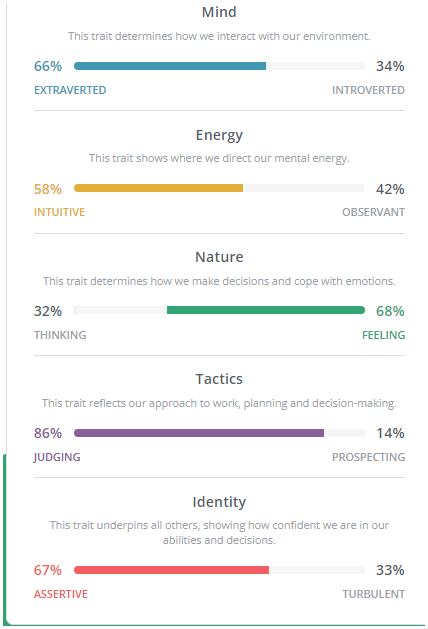
(Source: https://www.16personalities.com/enfj-strengths-and-weaknesses)
Appendix 2: Leadership vision test
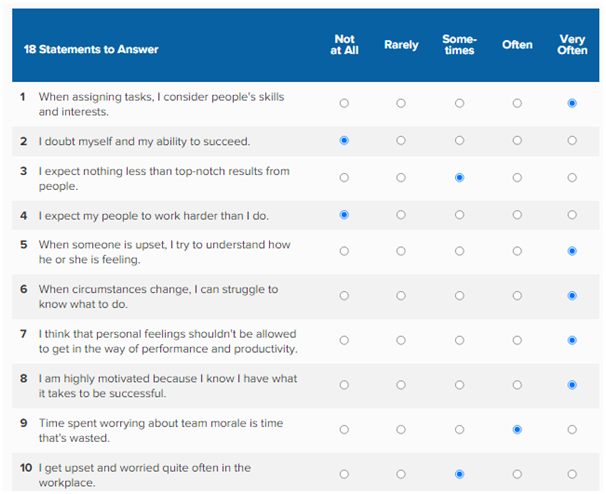
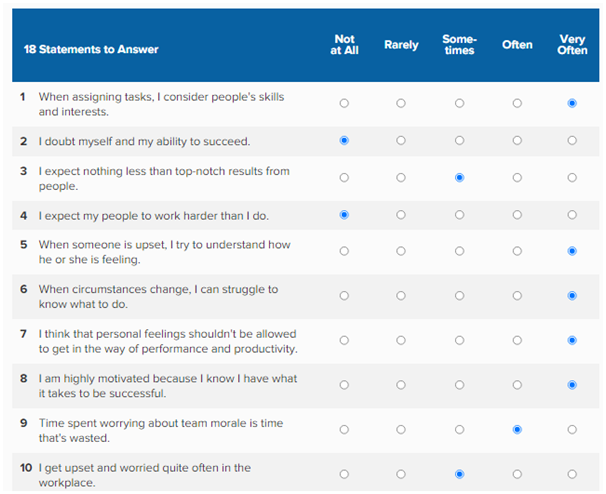
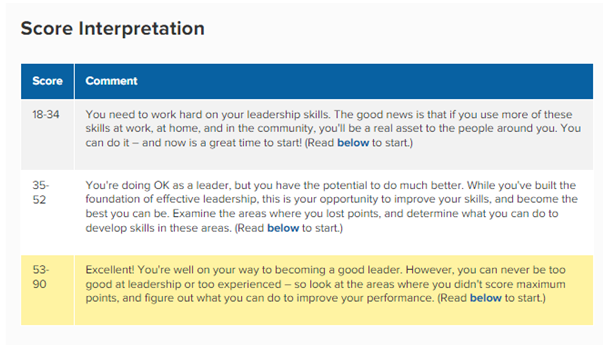
(Source: https://www.mindtools.com/pages/article/newLDR_50.htm)
Appendix 3: Johari window
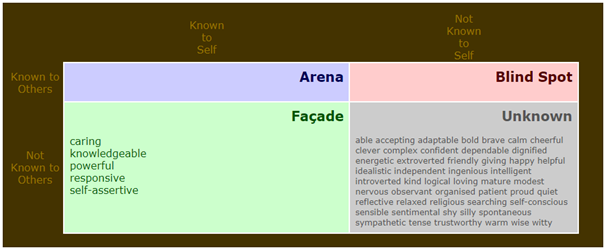
(Source: https://kevan.org/johariview=vansh+kak)
Appendix 5: 360-degree leadership test
